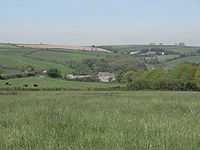Whympston, Modbury

Whympston in the parish of Modbury in Devon, England, is a historic manor. In the 12th century it became the earliest English seat of the prominent Norman family of Fortescue, influential in British and West Country history, which survives today as Earl Fortescue, seated at Ebrington in Gloucestershire, but until recently seated at Castle Hill and Weare Giffard in Devon.
Descent
Fortescue
As the 17th-century Fortescue mural monument in the parish church of Weare Giffard (see below) states, "Whympstone" (modern spelling "Whympston") in the parish of Modbury is the oldest known home of the Fortescue family. The manor of Whympston is thought to have been granted to them by King John in 1209, but according to Hoskins[1] they were already in the district in about 1140 when Ralph Fortescue donated some land to Modbury Priory at about the time of its foundation.
Fortescue monument, Weare Giffard

On the south wall of the south aisle chapel ("Fortescue Chapel") of the parish church of Weare Giffard is affixed the Fortescue mural monument, erected in 1638[2] by Hugh Fortescue (1592-1661). Inscribed across the monument at the top of the lower (second) tier is the following Latin text, which summarises the history of the Fortescue family:
Memoriale Hugonis Fortescue arm(igeris) et Elizabethae ux(oris) filiae Joh(anni)s Chichester Equit(is) itemque Joh(ann)is Fortescue eorum fil(ii) arm(igeris) et Mariae ux(oris) filiae Humphredi Speccot de Thornbury arm(igeris) Sunt hi ab Joh(ann)e Fortescue Equite Duce castri de Meaux in Gall(ia) sub H(enrico) 5.o (Quinto) oriundi qui praesepia Fortescutorum de Wimeston Devon ortus habuit fil(ium) Joh(ann)em Summum Justic(ium) et Cancell(arium) sub H(enrico) 6.o (Sexto) sepultum Ebertoniae Glocest(ria) Familia quidem perantiqua et etiamnum felici subole propagata sepulti sunt: Hugo, Aug. 2 1600; Joh(ann)es April 5, 1605: Elizabetha May 7, 1630; Maria April 11, 1637.
Which may be translated literally as:
"In memory of Hugh Fortescue, Esquire, and of Elizabeth his wife, daughter of John Chichester Esquire and also of John Fortescue, the son of them, Esquire, and of Mary his wife, daughter of Humphrey Speccot of Thornbury, Esquire. These arose from John Fortescue, Knight, Captain of the Castle of Meaux in France, arisen under Henry the Fifth a scion of the Fortescues of Whympston, Devon. He had a son John, Chief Justice and Chancellor under Henry the Sixth. He was buried at Ebrington in Gloucestershire. Indeed the very ancient family even now is happy with fruitful issue and are buried here: Hugo, Aug. 2 1600; John April 5, 1605: Elizabeth May 7, 1630; Mary April 11, 1637
The Fortescue family sold the estate shortly before 1600.[3]
Treby
Writing in 1797 Swete stated it was then owned by Paul Treby Esq.[4] (1758-1832) of Plympton House.
Prettejohn
Walter Lamble Prettejohn (1787-1850) purchased the estate from Paul Treby and at some time before 1810 built a new house on the estate.[5][6] His memorial plaque survives in Chivelstone Church, inscribed as follows:[7]
- "Sacred to the memory of Walter Lamble Prettejohn late of Whymston in the Parish of Modbury son of Walter Prettejohn formerly of South Allington in this parish who departed this life the 7th of April 1850 aged 63 years".
The co-executrix to his will was his niece Elizabeth Prettejohn Pitts of Chivelstone, wife of Nicholas Pitts, Gentleman, and only child of his sister Elizabeth Harris.[8]
Pitts
In 1862 the estate was owned by Nicholas Pitts of South Allington.
Plymouth Co-Operative Society
The country mansion called Whympston House was purchased in 1916 by the Plymouth Co-Operative Society Ltd as a holiday home for its members. The sale catalogue of 1915 lists the following:[9]
"Whympston Estate, Stubston Estate, Lower Little Modbury Estate, Stoliford Estate, Challonscoombe Estate, Damerelscoombe Estate, Easton Estate, Bray's Wood (otherwise Braieswood) Tenement, Houghton Estate, Chantry Estate, Idestone Estate, Great Gate Estate, Alston Estate, fields called Tongue and South Down, several fields with barn and cattle linhays near Idestone Cross, Will Street meadow and pond in Loddiswell, Modbury, Aveton Gifford, Bigbury, Loddiswell and Malborough"
In 1925 the Co-Op sold the estate, as detailed in a sale catalogue of that year:[10]
"Whympston Estate including Stoliford Farm; Lower Little Modbury Farm; Stubston Farm; Whympston House and Farm, Modbury"
Present day
The site in 2012 at the end of a private lane marked "Whympston" comprises a small settlement of a modern-looking farmhouse with older farm buildings and two modern bungalows nearby. No trace of the former mansion house remains.
References
- ↑ Hoskins, W.G., A New Survey of England: Devon, London, 1959 (first published 1954), p.436
- ↑ Pevsner, Nikolaus & Cherry, Bridget, The Buildings of England: Devon, London, 2004, p.891
- ↑ Lysons, Samuel & Daniel, Magna Britannia 'Parishes: Maker - Musbury', volume 6: Devonshire (1822), pp. 326-360
- ↑ Gray, Todd & Rowe, Margery (Eds.), Travels in Georgian Devon: The Illustrated Journals of the Reverend John Swete, 1789–1800, vol.3, Tiverton, 1999, p.113
- ↑ Risdon, Tristram (d.1640), Survey of Devon, 1811 edition, London, 1811, with 1810 Additions, p.387
- ↑ Lysons, Samuel & Daniel, Magna Britannia 'Parishes: Maker - Musbury', volume 6: Devonshire (1822), pp. 326-360
- ↑
- ↑ Transcript of his will per
- ↑ Plymouth & West Devon Record Office Archives 1096/114 1915
- ↑ Plymouth & West Devon Record Office Archives 1096/278 1925